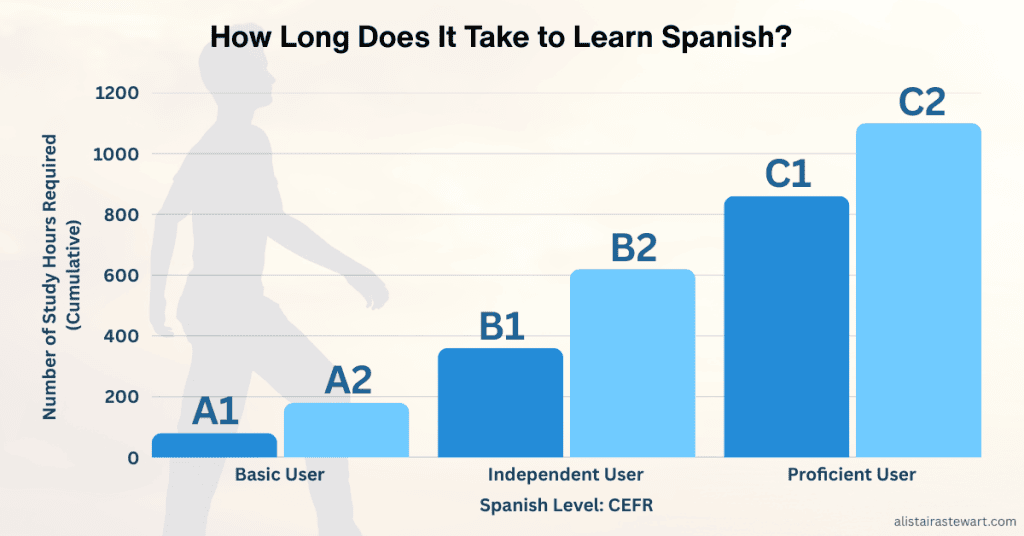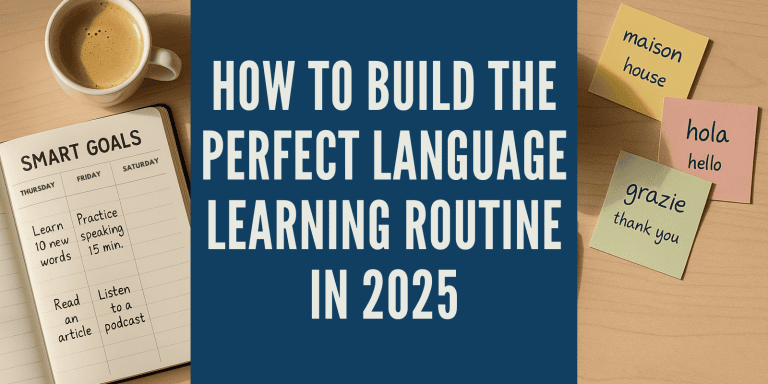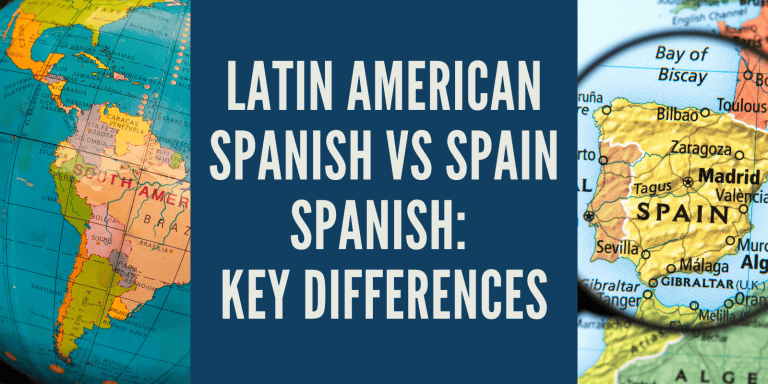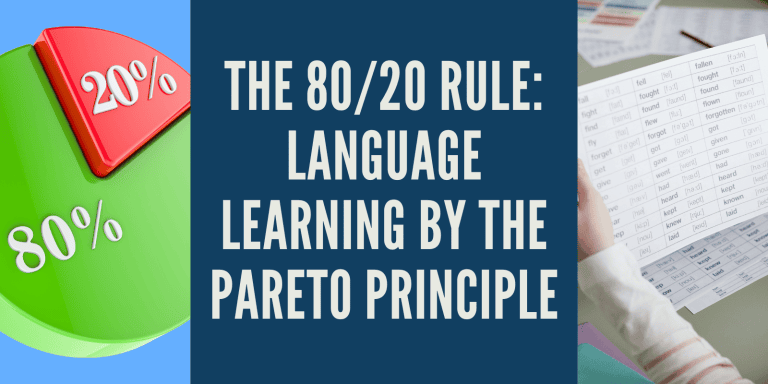How Long Does It Take to Learn Spanish?

When I first moved to Spain, the big question going through my head was, “How long does it take to learn Spanish?”
I remember sitting on the Madrid metro one morning, listening to two strangers chatting away. I literally didn’t understand a single word. They spoke so fast it was just noise, and this was after weeks (maybe months) of self-study. It was quite demotivating.
The good news is it doesn’t take forever. Spanish is one of the most accessible foreign languages for English speakers, thanks to its Latin origin and relatively straightforward grammar. But the timeline really depends on how you go about it.
Some learners achieve conversational fluency in a few months, while others study for years and barely progress beyond the basics. Why such a huge gap?
I’ve experienced this from both sides, and in this article, I’ll share how long it really takes to learn Spanish. I’ll look at the common mistakes that quietly hold people back and what actually helps you make progress.
Why So Many People Want to Learn Spanish
The Global Reach of the Spanish Language
The Spanish language is everywhere. It’s the second most spoken mother tongue in the world, with more than 480 million Spanish speakers using it daily. That puts it ahead of English in terms of native speakers, which surprises a lot of learners.

It’s also an official language in 20 countries, from Spain to across Latin America, and one of the six official languages of the United Nations. This means that if you know Spanish, you can travel widely, work internationally, and connect with people across continents without needing to switch to English.
For learners, this reach makes Spanish feel practical. You’re not just learning a language for one country – you’re gaining access to a global community.
Why Do People Want to Learn the Spanish Language?
Many people learn Spanish because it’s seen as one of the most accessible languages for English speakers. The grammar is logical compared to languages like Russian or Arabic, and the alphabet is the same as English.
Vocabulary is also easier than most new languages, since thousands of Spanish words share Latin roots with English. Think of animal, hospital, or color – they’re almost identical in both languages.
That doesn’t mean Spanish is effortless, but compared to other languages, it’s one of the most accessible you can choose. For busy adults, that combination of global usefulness and relative simplicity makes Spanish the clear winner.
What “Learning Spanish” Really Means
Conversational Spanish vs Mastering Spanish
When people say they want to learn Spanish, the goal can mean very different things.
For some, it’s being able to chat at a conversational level. Perhaps ordering food, asking for directions, or making small talk about familiar topics (despite small pauses or making mistakes). That’s what most learners call conversational Spanish.
On the opposite end, you have people aiming to be bilingual. This would effectively be using Spanish in the same way you do your native language.
That’s a much bigger challenge, so it’s important to be clear about your goal.
Basic Communication and Everyday Situations
The most common place to start is with greetings, numbers and useful phrases for travel. “Survival Spanish” – functional and helpful enough to get by in day-to-day situations.
At this point, it will be memorising Spanish words and set expressions. It will be limited, but think of it as laying the foundation for bigger things.
Professional Level Spanish and Working Proficiency
Reaching this level is a real step up from casual conversation. At this point, you would be able to hold your own in almost any setting.
You’ll have built solid grammar, a wide vocabulary, and the confidence to follow native Spanish speakers at normal speed without getting lost. You’ll also be able to explain your ideas clearly related to more specialised topics, your work and interests.
Of course, small mistakes are inevitable, and you won’t be mistaken for a native Spanish speaker, but hitting this level is a big achievement.
Now the Spanish language becomes a real tool for your career; not just something you study.
The Foreign Service Institute Estimates
Number of Hours Needed to Learn Spanish
The Foreign Service Institute (FSI) in the United States trains diplomats in new languages. Over decades, they’ve tracked how long it takes people to reach working proficiency in different languages.
FSI place the Spanish language in Category 1, the easiest group of languages for English speakers to learn.
According to the Foreign Service Institute estimates, it takes about 600–750 hours of focused study to reach professional working proficiency.
This is the equivalent of Level 3 of the IRL scale, and you could achieve this in around 30 weeks committing to 23 hours of study per week (plus practical self-application).
They do point out that the actual time required can vary depending on factors such as natural ability and previous language-learning experience. Which I’ll come to shortly.
What These Estimates Mean for Language Learners
Of course, these numbers are a useful guide but not a guarantee.
The FSI assumes structured, intensive study with teachers and full-time focus. Most people don’t learn under those conditions.
However, the message is still encouraging. With consistent effort, Spanish doesn’t take forever. You can make fast progress compared to languages like Arabic or Chinese, which the FSI says require around 2,200 hours.
Whether you learn in a classroom environment, online apps, or self-study, Spanish is one of the fastest wins for English speakers.
How Long Does It Take to Learn Spanish?
So, circling back to the question, “How long does it take to learn Spanish?” Let’s break it down a little bit more.
Common European Frameword of Reference for Languages (CEFR)
Another common guide to language level is the Common European Framework of Reference for Languages (CEFR)
I’ll use this Framework to explain what you should expect at each stage of your Spanish learning journey. Time estimates are based on part-time study in a non-Spanish speaking environment.

Basic Conversational Level (A1/A2)
- Reachable in about 3–4 months (≈80–180 hours).
- This is enough for very simple conversations about yourself and everyday needs (introductions, family, home, shopping)
- At this basic level, you’ll survive in Spanish with short exchanges, as long as the other person speaks slowly and clearly.
Intermediate Level Spanish Skills (B1/B2)
- Usually takes 6–12 months (≈360–620 hours).
- You can explain opinions and experiences in some detail, and handle everyday conversations in travel and work situations.
- You would be able to interact fairly fluently with native speakers, with detailed explanations and arguments on different issues.
Advanced and Professional Working Proficiency (C1/C2)
- Often requires 2+ years (≈860-1,100+ hours).
- At this stage, you can understand almost anything (spoken or written), including complex or subtle ideas, and communicate fluently and naturally without effort.
- You can use Spanish flexibly and precisely in any situation (social, academic, or professional) and produce well-structured, detailed speech or writing that conveys even fine shades of meaning.
Factors That Influence Your Spanish Language Learning
As I touched on above, there are several factors involved in how long it takes you to learn Spanish. And the time spent in the classroom is only one of them.
Your Native Language and Other Romance Languages
If your native language is English, then you already have an advantage.
When estimating how long it takes, the FSI categorised the Spanish language as category 1, as it’s regarded as close to English.
There are thousands of words in the English language that come from Latin. So, they look and sound similar to words in the Spanish language.
You have an even bigger advantage if you have prior knowledge of another Romance language – for example, Italian, Portuguese or French. The grammar and structure are similar, so your progress will be faster.
Your Learning Style and Study Habits
Everyone has a different learning style. Some people prefer grammar drills while others need conversational practice. But it’s important to get a mix of both.
Regular exposure to new vocabulary and a system for reviewing is important. So use things like flashcards, apps and reading.
How you handle learning vocabulary makes a difference, so find a method that suits you and stick to it.
Does Age Make a Different to Learning Spanish?
Your age doesn’t decide everything, but it does play a role.
Young learners generally absorb sounds more easily. They are more receptive than adults and learn languages more easily through immersion.
One thing I notice about teaching languages is that children generally have more confidence. They don’t care about making mistakes. Adults tend to be more self-conscious and afraid of making a fool of themselves. So stay within their comfort zone.
That said, adults can use stronger reasoning skills, but rely on explicit instructions and analysis.
Different Ways to Learn Spanish
As I’ve alluded to, there is no single best way to learn Spanish. It depends on your goals, budget and available time.
Classroom Learning and Group Classes
I like traditional classroom learning. But that’s because I like structure and need accountability. If it’s a well-designed course, you’ll cover grammar, vocabulary and practice conversations with other students.
Group classes are social, and you’ll hear different accents and can learn from other people’s mistakes as well as your own.
The disadvantage of this is the pace. You can only progress as fast as the teacher/class. Usually, classroom instruction is slower than studying by yourself. So, expect to spend months and years in a formal program.
Online Courses and Apps
There are countless online courses and apps out there.
I’ve reviewed some of the more popular ones, like Mondly, which is great for interactive learning. Or if you prefer a more structured course-like app, Rocket Spanish is my recommendation.
With these, you can study on your phone while commuting by train or bus. Or spend an hour or so in the evening doing online exercises. This usually includes dialogues, quizzes, and tracking your progress.
Most people find these easier than textbooks – possibly because we’re so used to using a device and screen for everything nowadays.
Just make sure you’re following productive lessons, and with this, you can expect decent progress in six to twelve months.
Language Immersion in a Spanish-speaking Country
Nothing beats immersion. If you live in a Spanish-speaking country, you have to use Spanish every day.
Learners in South America or Spain often reach conversational fluency much faster because they’re surrounded by the language for shopping, transport, and social life.
The difficulty is that immersion only works if you go outside your comfort zone.
When I arrived in Spain, it was easy to fall into an English-speaking environment. Most of the people I first met through work were British. I had to actively look for Spanish friends to force myself to speak Spanish.
Learning with Spanish Music and Spanish Podcasts
Active learning methods like listening to Spanish music and Spanish podcasts make learning fun.
However, instead of just listening passively, you should analyse the lyrics, repeat phrases, and mimic what you hear.
This kind of practice sharpens your ear for natural rhythms and expressions. It’s not a complete study plan, but it boosts your skills and keeps motivation high between more formal lessons.
How to Speed Up Your Spanish Learning
So, if you are really focused on learning Spanish, here are my tips…
Surround Yourself With Spanish in Everyday Life
One of the best shortcuts is to surround yourself with the language. So how do you do this (if you don’t live in a Spanish-speaking country)?
There are a lot of things you can do nowadays. For example, change your phone settings, watch TV shows in Spanish, read Spanish language newspapers online, or follow Spanish-speaking creators online.
Your brain will adapt much quicker with this exposure.
Of course, spending time with Spanish-speaking friends is even better.
Real conversations force you to respond quickly and expose you to natural expressions you won’t find in books. And make it active learning. Pay attention, repeat new phrases, and use them the next time you talk.
Build Strong Listening and Speaking Skills
Strong listening skills goes hand-in-hand with fluency. If you can’t understand native speakers, conversations break down.
So listen to podcasts, news, or short clips every day, even if you don’t understand every word.
And for communication, you need to speak Spanish regularly. This can be with other Spanish learners or native speakers.
Or even if it’s just recording yourself. Speaking out loud to builds confidence and reduces hesitation.
Use Conversation Practice to Learn Spanish Fluently
But of course, there is no substitute for practising conversation. Talking to a friend, teacher, or language exchange partner forces you to apply what you know.
It’s the fastest way to achieve fluency, because you’re actively building sentences instead of memorising and repeating them.
If your goal is to learn Spanish fluently, aim for short but frequent sessions. 20 minutes a day is more effective than two hours once a week. Over time, this steady practice builds the habit of thinking directly in Spanish.
Comparing Spanish to Other Foreign Languages
Learning Spanish vs Other Languages
For English speakers, Spanish is one of the most approachable choices. The Foreign Service Institute puts it in the “easiest” group for learners, while many other languages take two or three times longer to learn.
Compared to languages like Mandarin, Japanese, or Arabic – which require new writing systems and thousands of study hours – Spanish is much quicker to pick up. Even among European languages, Spanish grammar is simpler and more consistent than German or French.
That’s why learners often choose Spanish first: it’s practical, global, and less of a time investment than most alternatives.
How Long Does It Take To Learn Spanish? – Final Thoughts
The Key Takeaways
Remember, you are unique. And your path to learning Spanish will be too.
I remember getting agitated when a friend of mine in Madrid progressed so much faster than I did. Every time I met him, I was amazed at his progress. But he had a different lifestyle, routine, and worked in a fully immersive Spanish-speaking environment.
Stick with it and do the work regularly, and the learning process will move faster than you expect.
If you stay consistent, you will reach real conversations in under a year.
Why the Learning Process Never Really Ends
Languages aren’t something you finish; they’re something you grow with. Even fluent language learners keep discovering new words, expressions, and cultural insights.
The learning process shifts over time – from grammar drills at the start to refining nuance and style later on.
Encouragement for New Language Learners
So, if you’re starting a new language, don’t be put off by the long timelines. Every bit of practice counts, and small wins add up quickly.
Make Spanish part of your daily life, and if you can, spend time with Spanish-speaking friends. As I mentioned, real conversations are the fastest way to build confidence.
It will be challenging at times, but the rewards (new friends, new opportunities, and a richer world) are definitely worth it.
FAQs About Learning Spanish
Can you learn Spanish in 3 months?
You can definitely learn Spanish to a basic level in three months if you study every day. With focused practice, it’s possible to hold short conversations. But to learn Spanish fluently – where you can chat with ease and follow native conversations – you’ll usually need closer to a year or more.
Is Spanish really easier than French or German?
Yes, for most English speakers, Spanish is one of the easiest languages to learn. It’s a Romance language, like French and Italian, but with simpler grammar and more consistent spelling. That’s why it’s often described as one of the most accessible languages for beginners.
How many hours should I study Spanish per day?
Consistency is more important than marathon study sessions. I recommend aiming for 30–60 minutes a day, ideally split between structured lessons. Practice with real content and review past material. Mixing in grammar rules with activities that help you learn vocabulary keeps your study balanced and effective.
What’s the hardest part of learning Spanish for English speakers?
For many learners, Spanish grammar can be tricky at first—especially verb conjugations and the subjunctive mood. Others find fast speech a challenge, which is why building strong listening skills is essential. And of course, remembering all the new vocabulary takes time. The good news is that with steady practice, each hurdle gets easier.






